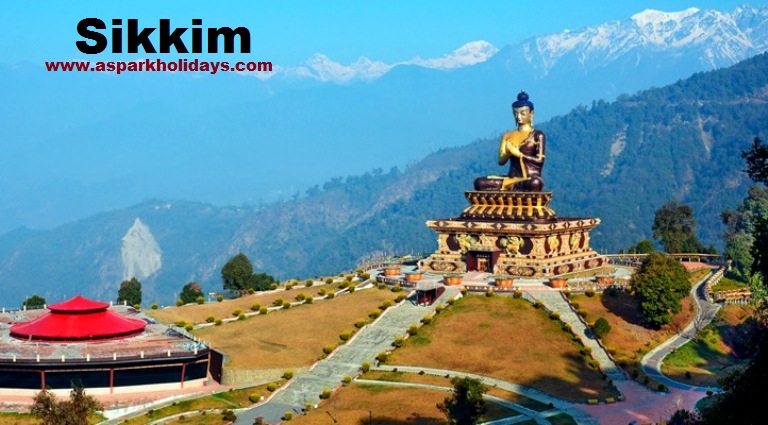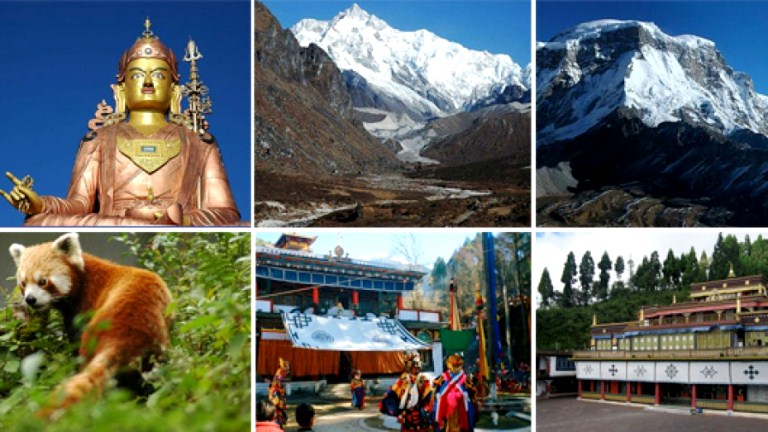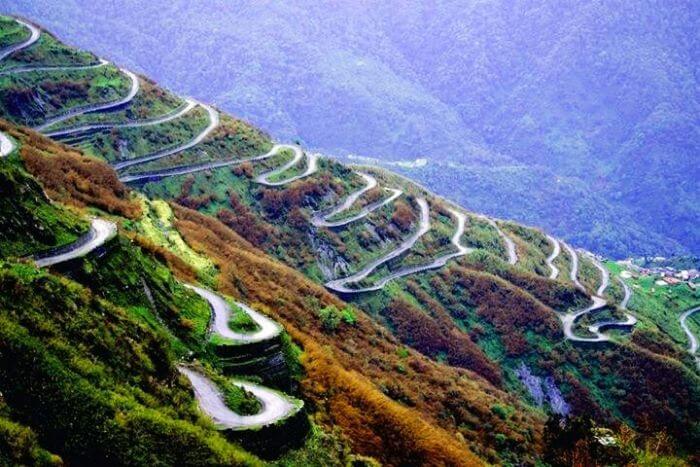
Located in the Northeastern part of the country, Sikkim is surrounded by West Bengal on its south and shares international borders with Bhutan on its southeast, Nepal on its west and the Tibet Autonomous Region of China on its northeast. The beautiful mountains, the deep valleys and the biodiversity make Sikkim a favorite spot for tourists. Gangtok is the capital as well as the largest city of Sikkim and is located at the height of 5500 feet on the hills of Shivalik. The beautiful Kanchenjunga, which is the third tallest mountain of the world, can be viewed from Gangtok. The total area of Sikkim is roughly 7000 square kilometres with a total population of more than 6 lakhs. Most of the areas being hilly, summers in Sikkim are soothing as the temperature hardly crosses 28 degrees whereas the inhabitants witness that spine chilling shiver during the winters with a temperature below freezing point. Sikkim became a part of India in 1975 and since then, the political structure of the state adheres to the rest of the country. The legislative assembly comprises of 32 members properly selected through elections.
History of Sikkim- History of Sikkim reflects the past of the territory of Sikkim. Sikkim has a rich past that sings the praise of the past events and kingdoms that ruled in the territory of Sikkim.
Although much is not known about the ancient history in Sikkim, it is evident that three tribes namely, Naong, Mon and Chang resided within the territory of Sikkim. But, these tribes could not retain their dominance over Sikkim for long; the Lepchas replaced the aforesaid tribes soon after they entered the territory of Sikkim.
The coming of the Lepchas and their settlement and combat with the aborigines of Sikkim constitute a major part of the early Sikkim history. But, the modern history of Sikkim is said to have begun in 1641.
Furthermore, with the arrival of the British in India, Sikkim allied with the British Empire to keep the Nepalese at bay. But, the collaboration of Sikkim with the British led them to suffer dire consequences.
Moreover, the history at Sikkim states that in 1947, after India got its Independence, Sikkim emerged as a special protectorate under the India Union. But, after the death of Tashi Namgyal, political ranks in Sikkim started crumbling down.
Prolonged agitation in Sikkimese led to the formation of an associate State, i. e. Sikkim was transformed from a protectorate state to an associate State of the Indian Union. On 4th September, 1947,Kazi Lendup Dorji was made the Chief Minister of the State. Finally, on 16th May, 1975, Sikkim became a part of the Indian Union and the institution of Chogyals were completely abolished.
Places to Visit in Sikkim- Sikkim is situated at the foot of Mount Kanchendzonga and boasts of an unexplored beauty. The lofty mountains dominate the skyline of Sikkim and invites tourists in its snow clad peaks, green emerald slopes, rushing streams, tall Rhododendrons and sparkling orchids. Hilltop monasteries emerge from the rugged terrains while multi-colored prayer flags wave in the mountain breeze.
Places to See in Sikkim- Sikkim Travel Map- The capital of Sikkim is a charming and picturesque town, straddling with striking houses spilling down the hillside. The city has a fusion of traditional customs and modern way of living which makes the place unique. It's a beautiful town with all modern amenities that one can ask for.
Yuksom- This was the first capital of Sikkim, where historical records say that the first divine ruler of Sikkim was sanctified in 1641 by the three learned lamas. The evidence of the ceremony is still present in Norbugang Chorten. The place is considered sacred since the history of Sikkim began from here. It's also the base camp for the trek to the famous Mt. Khangchendzonga.
Tsomgo Lake- The lake is about a kilometre long, oval in shape and is considered very holy by the locals. Between May to August, the lake area is spectacular with a display of rare flowers including the primulas, iris and blue & yellow poppies. The lake has a number of aquatic and aerial species and is a perfect habitat for the red panda. The lake freezes in winter.
Nathula Pass- At an altitude of 14200 ft, the pass is located on the Indo-China border and connects Sikkim to Tibet Autonomous Region in China. The journey itself is an exhilarating experience, with mist covered peaks, zigzag roads and roaring waterfalls, the passage is simply amazing. Visitors are required to get a permit to visit the place.
Pelling- Pelling is rapidly becoming a popular tourist destination. At an altitude of 6800 ft, it's the most excellent place to get a closest view of the world's 3rd highest peak Mt. Kanchendzonga. Apart from the innate beauty of the place, other attractions in Pelling are the Sanga Choeling Monastery, Pemayangtse Monastery and the Khecheopalri Lake.
The Rumtek Monastery- This magnificent monastery is among the top tourist attractions in Sikkim. It provides as a residence for the 16th Gyalwa Karmapa. The Monastery features some of the extraordinary works of art. The Golden Stupa is the most significant segment of the monastery.
Do-Drul Chorten- Built by the head of Nyingma order of Tibetan Buddhism in 1945, it has one of the most beautiful Stupas of Sikkim consisting of 108 prayer wheels. It stores various Mandala sets, a set of relics and some other religious possessions. Statues of Gurus are also present there.
Jawaharlal Nehru Botanical Garden- Established in 1987 the Jawaharlal Nehru Botanical Garden is situated near Rumtek Monastery and is looked after by the Forest Department of the Sikkim Government. The garden is distinguished by enchanting lush woodlands of Oak, different kinds of trees and orchids.
Sikkim Research Institute of Tibetology- It is a nationally well known centre of Tibetan Studies & Research. The institute is renowned for its huge collection of rare manuscripts, Buddhist books and icons. The building is an excellent example of Tibetan architecture, surrounded by small forests of oak and birch trees. The institute also houses religious works of art and amazing silk embroidered paintings.
Apart from these popular places, Sikkim provides various other places that are popular among tourist.
- Enchey Monastery
- Sa-Ngor-Chotshog Monastery
- Tashiding Monastery
- Phodong Monastery
- Phensang Monastery
- Saramsa Garden
- Tashi View Point
- Rabdentse Ruins
- Soreng
- Lachung
- Yumthang
- Guru-Dongmar Lake.
Tourist Destination Near Sikkim
Darjeeling- One of the most captivating tourist places near Sikkim with popular toy train ride to famous Darjeeling tea plantations. There are lots of tourist attractions at this place.
Siliguri- With its exquisite landscape, distant views of the snow capped peaks and myriad vegetation, Siliguri is a place where tourist can enjoy nature fully.
Kalimpong- A fascinating tourist destination near Sikkim which acknowledges its rustic charm, dotted with numerous orchids and monasteries. It's an ideal place for relaxed vacations against the picturesque backdrop of the Himalayas and also a great place for adventure junkies.
Mirik- Popular for its famous Lake and lovely surroundings, this exotic place is perfect for romantic holidays for the newly weds.
Sikkim Climate- Apart from the picturesque locales, the climate of Sikkim also serves to be another major enticement for the tourists who descend from all across the globe to witness its scenic beauty. Ambiguities with regards to the prevailing climate always exists as the weather that predominates in the northern fraction of the state is entirely different from the conditions that are experienced in the southern extremities.
The climate of Sikkim can be categorized as tundra-type in the northern parts whereas the inhabitants residing in the southern wing of the state have to put up with sub-tropical type of weather. An astonishing fact is that the climate in the densely populated regions of Sikkim are of the temperate type.
The average temperature that very rarely crosses the 28 degree Centigrade or 82 degree Fahrenheit mark during the months of the summer season. Whereas, the winter season sends a spine-schilling shiver down the spines of its occupants as astoundingly low temperatures below 0 degree Celsius are recorded which is equivalent to 32 degree Fahrenheit.
The bunch of seasons that characterize the climate in Sikkim are spring, summer, winter, monsoon and autumn. The climate at Sikkim is such that the rainy season extends from the month of June to September. As a matter of fact, Sikkim is perhaps one of the very few states to be blessed with consistent events of mesmerizing snowfalls. Owing to this fact, an absolutely astonishing 6000 meters of snow line has been recorded there.
However, one jeopardy that the inhabitants have to live with due to the Sikkim climate are the frequent landslides which are an aftermath of the occasional torrential downpour that the state has to withstand. Temperatures as low as -40 degree Centigrade have also been measured in the northern areas. Fog also poses a lot of hazards in the way of proper transportation.
Need Aspark Help?
For Tour Packages, Vehicle Rental and Customer Care Support.
+91 9999 31 7846
booking@asparkholidays.comWhy Travel with Us?

Excellent Support
Our Team Available 24x7 for Customer support
Best Price & Savings
We Offer the Most Competitive Prices.


